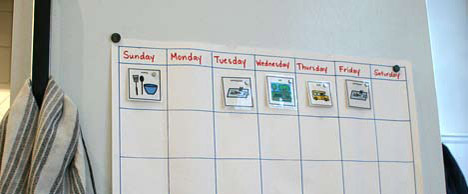
A calendar can serve a wide variety of purposes. Calendars can help us remember what we have to do, where we are going to be, and when we will be there.
Young children usually think about things that are happening at this moment in time. They may have difficulty understanding the difference between today, tomorrow, and next week. Whether you are a parent, teacher or early childhood professional, you can use an activity calendar to help your child to see what will happen during the day or in the future. It’s also a fun way to learn the days of the week.
An activity calendar can be created to depict the daily, weekly, or monthly schedule. A daily calendar or schedule shows the main activities that will take place during the day. A weekly calendar can focus on the events that will occur during the week. A monthly calendar is great for highlighting events that take place on a regular basis throughout the month, like swimming, or to indicate special events like a trip or birthday party.
How to Make a Calendar:
You will need:
- a sheet of bristol board
- mactac
- velcro
- markers
- glue or tape
- computer and printer
Steps:
- Print out the days of the week.
- Print out the template you would like to use daily, weekly, or monthly.
- Cut out the days of the week and glue one to each box on the top row.
- Cover with mactac, if available.
- You may also buy a large calendar at your local office supplies store.
- Once you calendar is ready, attach your symbols – you can use tape, Velcro, or sticky tack.
- Create your own activity symbols by taking photographs, cutting pictures out of magazines, drawing your own, or visit the Visuals Engine to print picture symbols (simple line drawings that represent real events, activities, people, etc.) or photos.
How to use:
- Let your child/children know that you will be making a special calendar, just for them.
- Place the calendar in a location where it can easily be seen, at eye level and where there are not too many distractions.
- Decide on the type of visuals you are going to use, such as picture symbols, or real photos. Help your child understand what the visuals mean. For example, before lunch time point to the picture and say, “Time for lunch”.
- Add the picture symbols or photos of the main activity for each day, such as playground or lunch.
- Adding activities that are different from your child’s usual routine is important. If your child has to miss playground because of rain and will be doing an indoor activity instead, putting it on the calendar can help him prepare for this change in his routine.
- Be sure to add events that your child is looking forward to, such as birthdays and holidays.
- Activity calendars help to promote the development of receptive language skills. Your child will hear and learn new words/phrases and begin to understand concepts like time. For example, “Yesterday you went swimming. Today you will go to the playground.”
- Set aside a time each week to talk about plans for the upcoming week.
